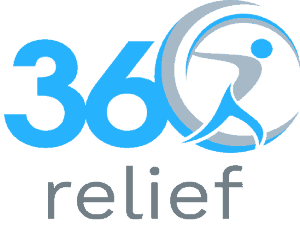
Make This Christmas Pain-Free: 10% Off on Supportive Wear!
Holidays are coming, which means that let’s welcome them with joy, laughter, and, of course, some comfort! At 360 Relief,

Persistent back pain can prevent you from getting a good night’s sleep and can be irritating. Sleep deprivation can aggravate symptoms of pain, increase daily fatigue, and contribute to a variety of health issues, including heart disease, weight gain, and diabetes. Therefore, you should always take night-time back discomfort seriously and try to figure out what’s causing it.
The majority of lower back discomfort is caused by an injury, such as muscle sprains or strains caused by rapid movements or poor lifting mechanics. Acute back pain can persist from a few days to a few weeks, while chronic back pain lasts for more than three months. Individuals between the ages of 30 and 50 are more prone to experience low back discomfort. This is due in part to the changes that occur in the body as people age. The fluid content between the vertebrae in your spine decreases as you become older.
Table of Contents
ToggleExcessive activity can stretch or tear the muscles and ligaments of the back. Lower back discomfort and stiffness, as well as muscle spasms, are common symptoms. These symptoms can be treated with rest and physical treatment.
Inactivity causes poor mobility, postural misalignment, and weak muscles, all of which contribute to back pain in different ways.
Tight gluteal and leg muscles pull on your lumbar spine, causing an excessive lumbar curve (lordosis). Tight shoulder and upper back muscles can also cause your spine to become misaligned.
Weak muscles, particularly the core, hips, glutes, and back muscles, do not adequately support your spine. This causes spinal misalignment and, as a result, lower back pain.
If you spend a lot of time sitting, you may have developed bad posture, such as slouched shoulders, a protruding neck, and an arched lower back. All of these posture issues can result in back pain.

Back discs are vulnerable to injury. With age, this danger rises. The disc’s outer layer can tear or herniate. When the cartilage surrounding the disc pushes against the spinal cord or nerve roots, it causes a herniated disc, also known as a slipped or ruptured disc. The cushion between the vertebrae of the spine expands beyond its normal position. Disc injury usually occurs as a result of a sudden movement such as lifting something or twisting the back.
A low back sprain or strain can occur suddenly or gradually over time as a result of repetitive movements.
Lifting a heavy object or twisting the spine while lifting are both dangerous.
Sudden movements that put too much strain on the low back, such as a fall.
Poor posture accumulates over time
Sports injuries, particularly those involving twisting or high impact forces, are common
When one vertebra slips over the adjacent one, this condition occurs. Spondylolisthesis can be classified into five types, the most common of which are caused by a defect or fracture of the pars (the space between the facet joints) or mechanical instability of the facet joints (degenerative). Instability (back) or nerve compression can both cause pain.
This condition is caused by disc and facet joint wear and tear. It can occur at a single or multiple levels of the lower spine and causes pain, inflammation, instability, and stenosis to varying degrees. Spinal osteoarthritis is associated with aging and progresses slowly. Spondylosis, or degenerative joint disease, is another name for it.
Acute spine fractures or dislocations can cause pain. Lower back pain that develops after a trauma, such as a car accident or a fall, should be evaluated by a doctor.
Spinal stenosis is a condition in which the spinal column narrows, putting pressure on the spinal cord and nerves. The most common cause of spinal stenosis is degeneration of the discs between the vertebrae. As a result, bony spurs or soft tissues such as discs compress the nerve roots or spinal cord.
Numbness
Cramping
Weakness
One of the most common causes of chronic back pain is muscle deconditioning, also known as muscle atrophy. Muscle deconditioning occurs when your back muscles lack the strength and stability needed to properly support you, resulting in wear and tear over time.
You can avoid or reduce the occurrence of back pain by improving your physical condition, wearing Back Braces and support, learning and practicing proper body mechanics.
Regular low-impact aerobics activities that do not strain or jolt your back can increase back strength and endurance while also allowing your muscles to function better. Walking and swimming are both good options. Discuss which activities you might want to try with your doctor.
Being overweight puts a strain on the back muscles. If you’re overweight, losing weight can help avoid back pain.
Back support belts are ideal for people suffering from chronic back pain, sciatica, herniated discs, scoliosis, spinal stenosis, hip pain, post-surgery, and other conditions; it allows you to stay active, prevent injury, and boost performance while participating in sports, standing for long periods, or performing heavy lifting work. They are designed to provide comfortable support, appropriate compression, heat retention and back pain relief. These promote better circulation which aid in the prevention of back injuries as well as recovery.
Abdominal and back muscle exercises help condition these muscles so that they work together like a natural corset for your back.
Avoid lifting heavy weights; however, if you must lift something heavy, let your legs do the work. Maintain a straight back (no twisting) and only bend at the knees. Keep the weight close to your body. If the object is heavy or awkward, find a lifting partner.

Holidays are coming, which means that let’s welcome them with joy, laughter, and, of course, some comfort! At 360 Relief,

Happy Cyber Monday to everyone; it is a perfect occasion for 360 Relief to offer a special discount of 10%

This Black Friday, take advantage of exclusive 10% savings on some of 360 Relief’s best-selling compression socks and support braces!

Everyday life includes walking up stairs, but knee discomfort can make this basic activity difficult. Walking up or down stairs

Cooking is a beloved activity for many, but for those struggling with knee pain, standing in the kitchen can quickly

We’ve all been there. On a ride in a car, for instance, to the country home for a weekend break

Gardening is enjoyable for many people and those who like tending to their lawns and plants usually find it therapeutic

Do you have a painful knee problem that takes you to physiotherapy…for an injury that hampers your daily living…your workout

Training can be very much associated with some pains and injuries that may be experienced by the trainers. As there

Office workers often spend hours seated at their desks, focusing on tasks while unknowingly putting their health at risk. The

Winter often brings more than just a change in weather; for many, it also means dealing with unexpected swelling in

Compression socks have become a critical tool for athletes across all sports. Whether you’re a marathon runner, cyclist, or weightlifter,

October marks the beginning of National Cholesterol Month in the UK, a time dedicated to raising awareness about cholesterol and

Overall, there is nothing to match the experience of watching musicians perform live in an outdoor concert in Glastonbury. However,

Today charity runs have gained popularity as a way of raising cash for a cause in the United Kingdom. From
Please enter your email to subscribe to our newsletter for exclusive offers and updates
Copyright © 2025 | 360 Relief Ltd | Sitemap

